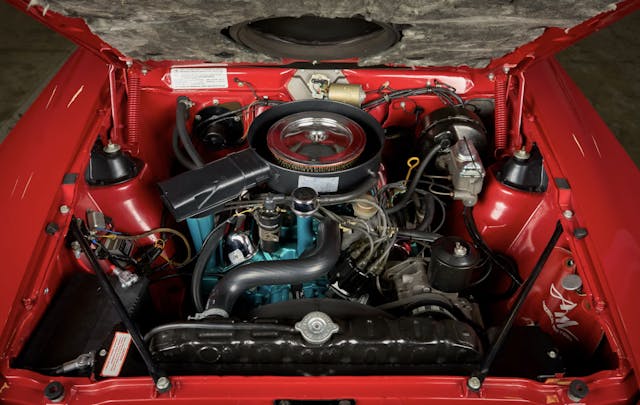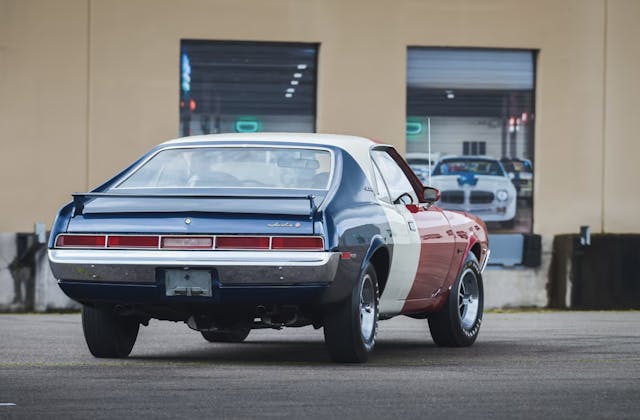Nothing says America like AMC’s baddest Javelin
AMC doesn’t get enough credit. The brand had a few models with questionable yet strangely appealing styling—Gremlin, Matador coupe, we’re looking at you—but many of their cars were absolutely stunning. On the powertrain front, their inline-six engines are renowned for their ruggedness, and the brand’s V-8 engines are nothing short of underrated. Always the odd manufacturer out given the Big Three’s presence, AMC managed to punch above its weight on several occasions. Few examples highlight that better than the Javelin Trans Am, a fine example of which is up for grabs at Mecum’s 2023 Dallas sale.

Not only did the 1970 model mark a one-year-only run of the 1970 Javelin twin-venturi grille, but just 100 copies of the 1970 Javelin Trans Am were built, and each of them was painted in red, white, and blue to honor the 1968 Trans Am entry of Peter Revson. This one was also equipped with a close-ratio four-speed manual transmission, a limited-slip rear axle with 3.91:1 gears, power steering, power brakes with front discs, and AMC’s Handling Package that included heavier-duty springs, sway bars, and shocks.
1970 was a big year for AMC. It was then that Penske Racing moved its Trans Am racing effort, along with ace driver Mark Donohue, from Chevrolet over to the scrappy, underdog AMC team. That same year, the SCCA, Trans Am’s sanctioning body, allowed manufacturers to use destroked versions of production engines to meet the maximum engine displacement of 5.0-liters, rather than selling 5.0-liter engines in homologation cars. Ford continued to offer a 302 in its production Mustangs, but other manufacturers in the series gave their road-race-flavored pony cars more cubes. For Chevrolet, that meant the end of the 302, with the 350-cubic-inch LT-1 taking over the reins in the 1970 Z/28. For Plymouth and Dodge, it meant that its 340 would be the basis of its Trans Am variants with the AAR ‘Cuda and Challenger T/A getting triple-carb versions of the engine. Both Pontiac and AMC, meanwhile, decided to let their V-8 engine families, with their wider bore spacing, go even bigger. Pontiac went with a nice, round 400 cubic inches, and AMC went with the biggest bore of any of them, equipping the racy red, white, and blue Javelin Trans Ams with a 390 V-8.

The big, 4.165-inch bores of the 390 were topped by newly developed cylinder heads that featured dogleg exhaust ports developed with help from cylinder head guru Larry Ofria. Rated at 325hp, they were capable of much more with the same kind of hot-rodding that worked on every other muscle car engine. As a result, the AMC 390s developed a solid reputation for power on the street and on the dragstrip. That reputation had big help though, from the tri-colored racers that were going wheel-to-wheel with the Big Three on road courses.
The AMC team proved to be tough competition for Ford and juggernaut Trans Am driver Parnelli Jones, who took the checkered flag in six of the 11 contests held across America and Canada during the 1970 Trans Am season. Mark Donohue won three of the five remaining races, giving AMC a second-place finish behind Ford in the manufacturer’s championship and proving that the Kenosha, Wisconsin, automaker could build a formidable race car and scrap with the big boys. The following year, behind a dominating performance from Donohue, AMC took the Trans Am championship. Donohue’s car, by the way, was painted in a similar fashion to the car Revson had raced in 1968, but with the colors in the scheme reversed.

The efficient lines of the 1970 AMC Javelin, understated compared to the brawny, flared curves of the final Javelins that debuted in 1971, are still enough to make a statement amongst the Mopars, Fords, and Chevys that are much more common at a typical car show. Add the patriotic Matador Red, Frost White, and Commodore Blue paint scheme, and these already rare sights become that much more of a standout. For such a low-production car to be this attractive and relatively affordable is even more rare. Whoever takes this car home will have a worthy cornerstone for their pony car collection.

***
Check out the Hagerty Media homepage so you don’t miss a single story, or better yet, bookmark it. To get our best stories delivered right to your inbox, subscribe to our newsletters.



I miss AMC!
love it!
The nicest Javelin ever produced! Far superior styling to the same vintage AMX.
Us Wisconsin guys appreciate the love! Any Road America fan loved the AMC Javelin Trans Am cars. Donohue was dominating both Trans Am and Can Am at the time of his demise. A buddy of one of my brothers raced a former Bud Moore 70′ Boss 302 in A Sedan SCCA mid-70’s. They were cheap used up race cars then..
Nothin’ like a “Kenosha Cadillac”!
Not for nuthin’, but would the person who put the AMC plate on the front of the car, please go back and straighten it out?
And the R/L outside mirrors look a little wonky. Period correct or wrong brackets? Maybe the Kenosha plant was built on the side of a hill?
It looks good. Always nice when we get an AMC car at a show.
Loved my AMX and my Dad’s Javelin. And for the earlier comment, did ANYONE look at the car before shooting the front pic, gawd the plate is CROOKED !!! AHHHHH. For the L&R mirrors they look as they have been remounted, in the wrong place ?? They should sit close to the front edge of the door and not with that goofy coloured leading cap. Still love the cars.